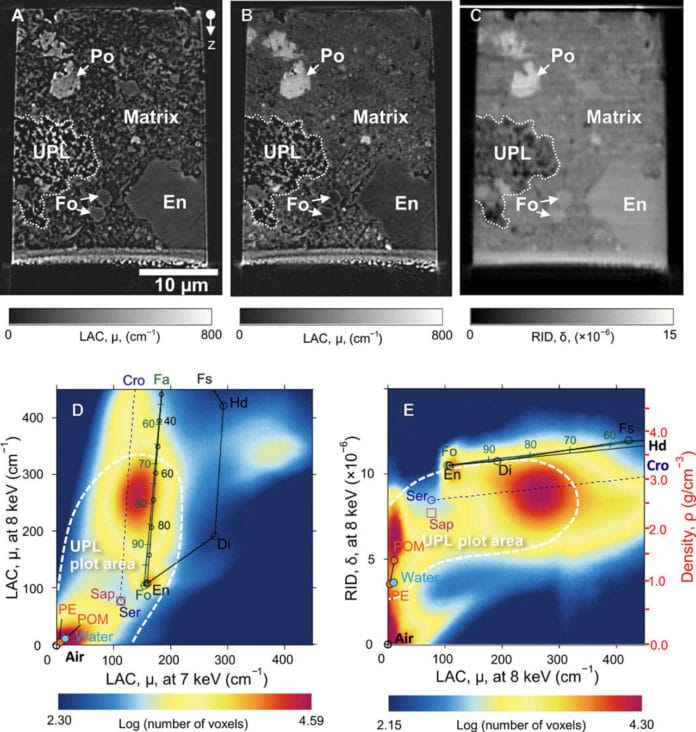Ice fossils found in meteorite
Evidence of ice fossils on the surface of a meteorite.
BY
AMIT MALEWAR
NOVEMBER 25, 2019
 XCT slice images of equant samples of the Acfer 094 matrix and their 2D histograms of LAC and RID values at 7 and 8 keV. Absorption XCT images at 7 keV (A) and 8 keV (B), as well as a phase XCT image at 8 keV (C), indicate an UPL embedded in the matrix. 2D histograms of LAC values at 7 and 8 keV (D) and LAC and RID values at 8 keV (E) of the matrix show peaks around the air, resin [polyacetal (POM)], forsterite (Fo), enstatite (En), and serpentine/saponite (Serp/Sap)–cronstedtite (Cro). Those plots of UPL have peaks in the areas surrounded by white dashed lines in (D) and (E). The density scale corresponding to the RID values is shown in (E). Fa, fayalite; Di, diopside; Hd, hedenbergite; Fs, ferrosilite; Po, pyrrhotite; PE, polyethylene. Credit: Science Advances (2019). DOI: 10.1126/sciadv.aax5078
XCT slice images of equant samples of the Acfer 094 matrix and their 2D histograms of LAC and RID values at 7 and 8 keV. Absorption XCT images at 7 keV (A) and 8 keV (B), as well as a phase XCT image at 8 keV (C), indicate an UPL embedded in the matrix. 2D histograms of LAC values at 7 and 8 keV (D) and LAC and RID values at 8 keV (E) of the matrix show peaks around the air, resin [polyacetal (POM)], forsterite (Fo), enstatite (En), and serpentine/saponite (Serp/Sap)–cronstedtite (Cro). Those plots of UPL have peaks in the areas surrounded by white dashed lines in (D) and (E). The density scale corresponding to the RID values is shown in (E). Fa, fayalite; Di, diopside; Hd, hedenbergite; Fs, ferrosilite; Po, pyrrhotite; PE, polyethylene. Credit: Science Advances (2019). DOI: 10.1126/sciadv.aax5078
In the early Solar System, dust grains, including ice, accreted to form planetesimals, and subsequent collisions and coalescing of planetesimals resulted in the formation of large planets.
The unblemished dust no longer exists in its unique structure in the present Solar System. Yet, its subordinates are found in small bodies that have not developed into planets: comets and asteroids.
Recently, a team of scientists from Japan, China, and the U.K. has discovered ice fossils on the surface of a meteorite. The Acfer 094 meteorite was found in the Algerian mountains back in 1990—since that time, it has undergone intense scrutiny due to its age—it has been dated back to approximately 4.6 billion years ago, which makes it a primitive meteorite.
The 82-gram meteorite is believed to harbor evidence of the primitive solar system and may, therefore, be able to provide scientists with clues about how planets and other celestial bodies formed.
More:
https://www.techexplorist.com/ice-fossils-found-meteorite/28010/?utm_source=BN&utm_medium=BN&utm_campaign=BN&utm_term=BN&utm_content=BN
